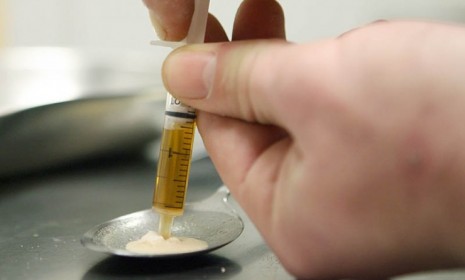The 'disastrous' Russian drug that rots human flesh
Krokodil, a dangerous narcotic that may be spreading through Western Europe, has some gory, and deadly, side effects

Krokodil is an underground narcotic that possesses a nasty side effect: It causes users' flesh to rot. Its use has been mostly confined to Russia, although authorities believe the synthetic opiate has recently hit Western Europe after reports of customers with "disastrous" skin deformities showing up in German drug cafés. Here, a brief guide to the drug and its stomach-churning side effects:
Why is it called krokodil?
Quite simply, it earns "its reptilian nickname by turning users' skin scaly," says CNN, "eating them from the inside, and rotting the brain and limbs, before precipitating a painful death." Graphic videos can be found all over YouTube, highlighting krokodil users' gory symptoms, which include gangrene, infections, and sores open all the way to the bone.
The Week
Escape your echo chamber. Get the facts behind the news, plus analysis from multiple perspectives.

Sign up for The Week's Free Newsletters
From our morning news briefing to a weekly Good News Newsletter, get the best of The Week delivered directly to your inbox.
From our morning news briefing to a weekly Good News Newsletter, get the best of The Week delivered directly to your inbox.
What is it made of?
It's a cocktail made by mixing codeine, benzine, paint thinner, hydrochloric acid, and red phosphorus. It's the hydrochloric acid that causes "the eventual destruction of the skin," says Keith Veronese at io9. One reason for the drug's prevalence is that it can be cooked up cheaply in a homemade kitchen — no fancy lab required. Producers often substitute ingredients (like using gasoline as a solvent, or getting phosphorous from the striking surface on matchboxes), which further impurifies the mixture and sickens users.
Why is it so addictive?
Krokodil is an extremely cheap alternative to a heroin high, says Veronese. It's just $6 to $8 per injection — compared with $150 for heroin. And its active ingredient, desomorphine, "is 8-10 times more potent" than morphine (which is used in heroin). Users who try to quit typically experience painful withdrawals, with success requiring a "phenomenal amount of willpower"; krokodil junkies typically live just three years after starting, with many dying within their first year.
A free daily email with the biggest news stories of the day – and the best features from TheWeek.com
Why is it so prevalent in Russia?
Two reasons: First, its essential ingredient, codeine, is available in Russia without a prescription. Codeine pills in particular are widely available, and can be cooked into krokodil in a half-hour. Second, the rehab system in Russia is essentially nonexistent, leaving users crippled under the weight of their own addictions. The drug's use is so widespread the amount of krokodil seized in the country has "increased 23-fold" since 2009, and in some regions it has even "pushed out traditional opiates."
Sources: CNN, io9, TIME, World Crunch
-
 7 bars with comforting cocktails and great hospitality
7 bars with comforting cocktails and great hospitalitythe week recommends Winter is a fine time for going out and drinking up
-
 7 recipes that meet you wherever you are during winter
7 recipes that meet you wherever you are during winterthe week recommends Low-key January and decadent holiday eating are all accounted for
-
 Nine best TV shows of the year
Nine best TV shows of the yearThe Week Recommends From Adolescence to Amandaland